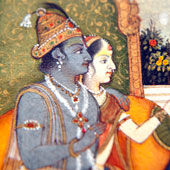Miniature Painting
Painting tradition in India dates back to the primitive era. People for ages have been painting in caves, walls, leaves etc. and it is spread all across the country. In Rajasthan miniature paintings had four main schools under which several centers flourished having different styles and color combinations. The main centers were
• Mewar School : Main centers were Chittor, Udaipur and Nathdwara.
• Amber ‐Jaipur School: Main centers were Amber, Jaipur and Alwar.
• Marwar School : Main centers were Bikaner, Jodhpur, Kishangarh, Jaisalmer and Ajmer.
• Bundi‐Kota School: Main centers were Bundi, Kota, Jhalawar.
In Jaipur, the craft is practiced by various people in different parts of the city.
Artisan and Community:
The artists who are engaged in the making of miniature paintings are called Chitrakars. Traditionally, the art was practiced by people of any caste and was not restricted by religion. Kings and other prominent personalities encouraged artists to paint and patronized artists with high skills. Since the craft was brought by Mughals therefore both Hindu and Muslim Chitrakars were involved in making paintings that had their respective distinctive styles. However, the artists in most cases belonged to upper castes. Today, many students belonging to different casts and creeds learn this art and practice in their local areas.



